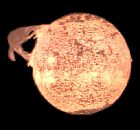 The inside structure of the Sun has been reconstructed by the theoretical elaboration of the known data. The inside structure of the Sun has been reconstructed by the theoretical elaboration of the known data.In the heart of the Sun is located a nucleus, with a ray of around 150.000 km, in which temperature and pressure are elevated enough to produce the nuclear fusion of the hydrogen in helium. The energy so produced is transmitted toward the outside with a radiation process that involves the surrounding gaseous wrap (radiative zone), approximately 500.000 km thick, in which the atoms absorb and give out energy but, because of the small temperature, don't produce nuclear reactions. At a depth of 130.000 km the gases, submitted to a small pressure, become less stable and gigantic convective movements are primed: the top of this third solar portion (convective zone) is what forms the bright surface of the Sun. Such surface, called photosphere, shows a structure with bright granules; it is wound by a wrap of incandescent gas, the chromosphere, that becomes visible during the solar eclipses. Even more to the outside, there is the crown, constituted by ionized gas, from which depart the solar wind, particles that are endowed with enough speed to escape the gravitational attraction of the Sun and that therefore go away in the space. |
Diameter | 1.392.000 km |
|---|---|---|
| Volume | 1,412 x 10^18 km³ | |
| Mass | 1,98 x 10^30 kg | |
| Average density | 1,41 kg/dm³ | |
| Surface temperature | 6.000°K | |
| Center temperature | 15.000.000°K | |
| Period of rotation | from 25 days at equator to 34 days at poles |
|
| Apparent magnitude | -26,78 | |
| Absolute magnitude | 4,85 | |
| Stellar class | G2 |
 Back to Solar System page.
Back to Solar System page.